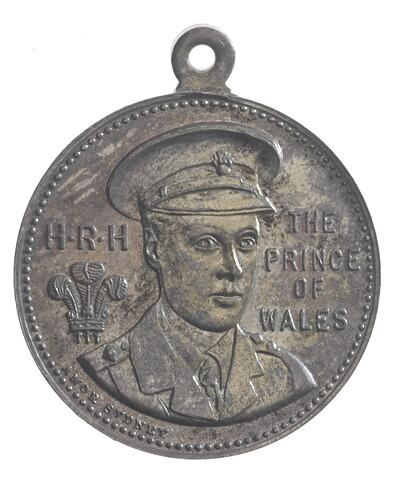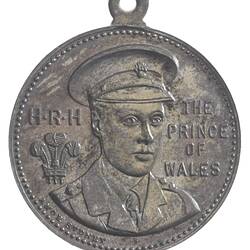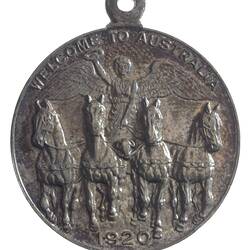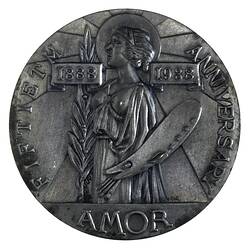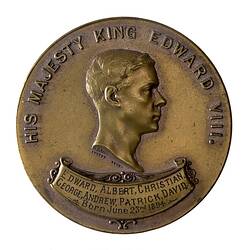Summary
Note: This description below includes white superiority messaging. Such attitudes and beliefs are not condoned by Museums Victoria which considers them to be racist. Historical distance and context do not excuse or erase this fact.
Australia New South Wales Sydney
Visit of the Prince of Wales 1920 (AD)
Mint: Amor
Other Details: In 1920 the Prince of Wales visited Australia to extend official thanks for its support during World War I and to strengthen links to the Empire. The Prince toured extensively, and his tour was one of the most popular royal visits ever. Wherever he went public holidays were declared, foundation stones laid, memorials unveiled and receptions and balls. The Prince made a point of meeting ex-servicemen and women. He spent nine days in Victoria, eleven days in New South Wales, four days in Tasmania, eleven days in Western Australia, six days in South Australia and eight days in Queensland. The Prince was seen as the embodiment of the White Australia, symbolic of the spirit of his race. His presence strengthened the identity of the young Australian nation as a member of the Empire, resisting the influence of other powers and other races.
Obverse Description
Bust of the Prince of Wales 3/4 right; behind Welsh plumes under H.R.H.; to right, THE / PRINCE / OF / WALES in tiny letters near rim at 07 the makers name, AMOR SYDNEY
Reverse Description
Victory drives a fast quadriga front, holds reigns in left hand and raises victory wreath in right; above, WELCOME TO AUSTRALIA, below, 1920
Edge Description
Plain
Significance
In 1920 the Prince of Wales visited Australia to extend official thanks for its support during World War I. The Prince toured extensively, and his tour was one of the most popular royal visits ever. Wherever he went public holidays were declared, foundation stones laid, memorials unveiled and receptions and balls. The prince made a point of meeting ex-servicemen and women. His popularity illustrates the complexity of Australia's self-awareness at the time.
The Prince's staff recorded that 'Confetti is appearing in great and unpleasant quantities, and the touching mania has started, only owing to the heartening disposition of the Australians the touches are more like blows and HRH arrived half blinded and black and blue...The 'touching mania', one of the most remarkable phenomena connected with my travels, took the form of a mass impulse to prod some part of the Prince of Wales. Whenever I entered a crowd, it closed around me like an octopus. I can still hear the shrill, excited cry, 'I touched him!' If I were out of reach, then a blow to my head with a folded newspaper appeared to satisfy the impulse.' (A King's Story: The Memoirs of HRH the Duke of Windsor).
The Prince spent nine days in Victoria, eleven days in New South Wales, fours days in Tasmania, eleven days in Western Australia, six days in South Australia and eight days in Queensland. The overland journey from South Australia to Queensland via inland New South Wales towns was scheduled to take ten days.
The Prince was seen as the embodiment of the White Australia, symbolic of the spirit of his race. His presence strengthened the identity of the young Australian nation as a member of the Empire, resisting the influence of other powers and other races.
The tour also came at a critical time for negotiations with Japan concerning the White Australia Policy. The Japanese Government had a valuable alliance with Britain which was due for renewal. The Australian Government hoped that the Japanese, in their desire to renew the alliance, would make concessions that would allow Australia to retain its internationally unpopular White Australia Policy and keep Japan out of the Pacific region. To its dismay, a navel review to be conducted for the Prince off Rabaul was boycotted by the Prince, whose advisors realised that it would have been a serious political error in light of the on-going negotiations with Japan.
-National Archives of Australia web site http://www.naa.gov.au/Publications/research_guides/guides/royalty/pages/chapter04.htm; Australian War Memorial web site http://www.awm.gov.au/forging/future/prince_visit.htm; Fewster, Kevin. 1980. Politics, Pagentry and Purpose: the 1920 Tour of Australia by the Prince of Wales. Labour History. 38 (May 1980). -D. Tout-Smith 29/9/2003.
More Information
-
Collecting Areas
-
Acquisition Information
Transfer from National Gallery of Victoria (NGV), 15 Mar 1976
-
Date Issued
1920 AD
-
Issued By
-
Mint
-
Person Depicted
HRH Edward A. Prince of Wales, Australia, 1920
Visited Australia to thank Australians for support in World War I. -
Series
-
Material
Silver-plated
-
Axis
12
-
Classification
-
Category
-
Discipline
-
Type of item
-
Dimensions
25 mm (Outside Diameter), 6.96 g (Weight)
-
Shape
Round with loop
-
References
Car.1920/3
[Article] Fewster, Kevin. 1980. Politics, Pagentry and Purpose: the 1920 Tour of Australia by the Prince of Wales. Labour History. 38 (May 1980): 59-66.
-
Keywords
Art Medals, Royal Visits, Wars & Conflicts, White Australia Policy, World War I, 1914-1918
